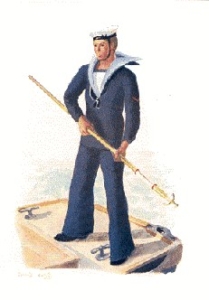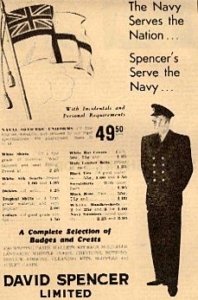 There is nothing uniform about uniforms. Their purpose may be to impose group identity on the individual, but in practice the need to be distinct often wins out over uniformity. Canadian sailors, like sailors the world over, have devoted much attention to the business of appearing distinguished – and distinct. In naval lingo, this is known as looking “tiddley,” (tiddley being the seaman’s term for neat or smart, something that must be fussed over).
There is nothing uniform about uniforms. Their purpose may be to impose group identity on the individual, but in practice the need to be distinct often wins out over uniformity. Canadian sailors, like sailors the world over, have devoted much attention to the business of appearing distinguished – and distinct. In naval lingo, this is known as looking “tiddley,” (tiddley being the seaman’s term for neat or smart, something that must be fussed over).
Here retired sailor John Scratchley recalls a few of the things the young Canadian matelot-about-town did to enhance his appearance:
“The #1 uniform was a sailor’s best, kept for ceremonial occasions and going ashore. The #1 uniform was often tailored to fit at the sailor’s own expense. It was made extra tight-fitting in the torso, and the trousers were more flared than the regulation issue bell-bottoms.
 “Then there was the cap, known as a “Port and Starboard”. This was something that every new entry bought before leaving basic training in HMCS CORNWALLIS. The navy gave you a pusser (regulation issue) cap, an awful oval thing that often didn’t fit the head too well and wasn’t comfortable.
“Then there was the cap, known as a “Port and Starboard”. This was something that every new entry bought before leaving basic training in HMCS CORNWALLIS. The navy gave you a pusser (regulation issue) cap, an awful oval thing that often didn’t fit the head too well and wasn’t comfortable.
“To make the cap look salty, with a bit of a bow-wave effect, you bent it over your knee a few times to get the right saddle-back shape. Sometimes, you could get away with a butterfly bow on your cap ribbon (known as a “tally”). This was a leftover from the Second World War and Korea, but pretty much passé by the 1960s.
“Collars were sometimes bleached to achieve the sought-after ‘salty’ look; this bleaching technique allowed even the OJT (on-the-job trainee) to appear as if he’d been there and done that.
“The same went for the blue-stripe at the neck of the gun shirt. All of which was supposed to make you look a little more salty, with a considerable amount of T.I. (time in).
“Many sailors visited the PX Stores on American bases. Some purchased US navy dungarees to wear with their working rig (known as #5s). The American dungarees were tighter fitting and made of denim. Some also purchased US navy shoes, which were lighter and more stylish than the ones issued to us in Canada.

14 July 1943 – A tiddley looking group of sailors indeed. Photo Catalogue No. VRP992.76.18 from the museum collection.
“Pusser boots were seldom worn ashore with #1s or #2s. After all, they looked like boots. For ceremonial divisions, it was common practice to take a pair of boots and burn them. Burning your boots caused them to develop a mirror-like finish. From then on in, it was necessary to spit-shine the boots in order not to mar the effect. The first step was to gob shoe polish on thickly, then set the polish on fire until the flame spread over the boot tip. An old tooth brush end was used in order to work the polish in evenly, while it was still hot. Quite a long process actually. From then on it was spit and a rag.
“A navy blue Burberry raincoat was the finishing touch to complete the ensemble. The RCN issued rain slickers, which were hot, uncomfortable and not stylish. So, on completion of basic training, the tiddley sailor purchased a Burberry.
“The coat had to be worn with a belt to distinguish it from the officer’s Burberry, which didn’t have a belt. With the addition of a white silk scarf, you were now becoming quite tiddley looking.
So this is some of what the tiddley sailor did in order to improve his appearance when venturing ashore either in home port or abroad.”
(To read more on the topic of getting tiddley and sailors’ deportment, here’s an article by a ‘Leading Seaman J.H.B.’ from the second issue of the Royal Canadian Navy magazine The Crowsnest, December 1948 ~ New Look Fails to Impress)
Editor’s note
Many of the tiddley uniforms worn by sailors at Naden during the Second World War were altered by O.W. Dyson. Dyson, a pre-World War II RCN rating in the gunnery branch (he was later commissioned), had a sewing machine and set up a small tailor shop at Naden. His son John, who became a Lieutenant-Commander, had fond memories of his father’s role in helping sailors look their very best.
 CFB Esquimalt Naval and Military Museum
CFB Esquimalt Naval and Military Museum CFB Esquimalt Naval and Military Museum
CFB Esquimalt Naval and Military Museum CFB Esquimalt Naval and Military Museum
CFB Esquimalt Naval and Military Museum CFB Esquimalt Naval and Military Museum
CFB Esquimalt Naval and Military Museum CFB Esquimalt Naval and Military Museum
CFB Esquimalt Naval and Military Museum CFB Esquimalt Naval and Military Museum
CFB Esquimalt Naval and Military Museum CFB Esquimalt Naval and Military Museum
CFB Esquimalt Naval and Military Museum CFB Esquimalt Naval and Military Museum
CFB Esquimalt Naval and Military Museum CFB Esquimalt Naval and Military Museum
CFB Esquimalt Naval and Military Museum CFB Esquimalt Naval and Military Museum
CFB Esquimalt Naval and Military Museum CFB Esquimalt Naval and Military Museum
CFB Esquimalt Naval and Military Museum CFB Esquimalt Naval and Military Museum
CFB Esquimalt Naval and Military Museum CFB Esquimalt Naval and Military Museum
CFB Esquimalt Naval and Military Museum CFB Esquimalt Naval and Military Museum
CFB Esquimalt Naval and Military Museum CFB Esquimalt Naval and Military Museum
CFB Esquimalt Naval and Military Museum CFB Esquimalt Naval and Military Museum
CFB Esquimalt Naval and Military Museum CFB Esquimalt Naval and Military Museum
CFB Esquimalt Naval and Military Museum